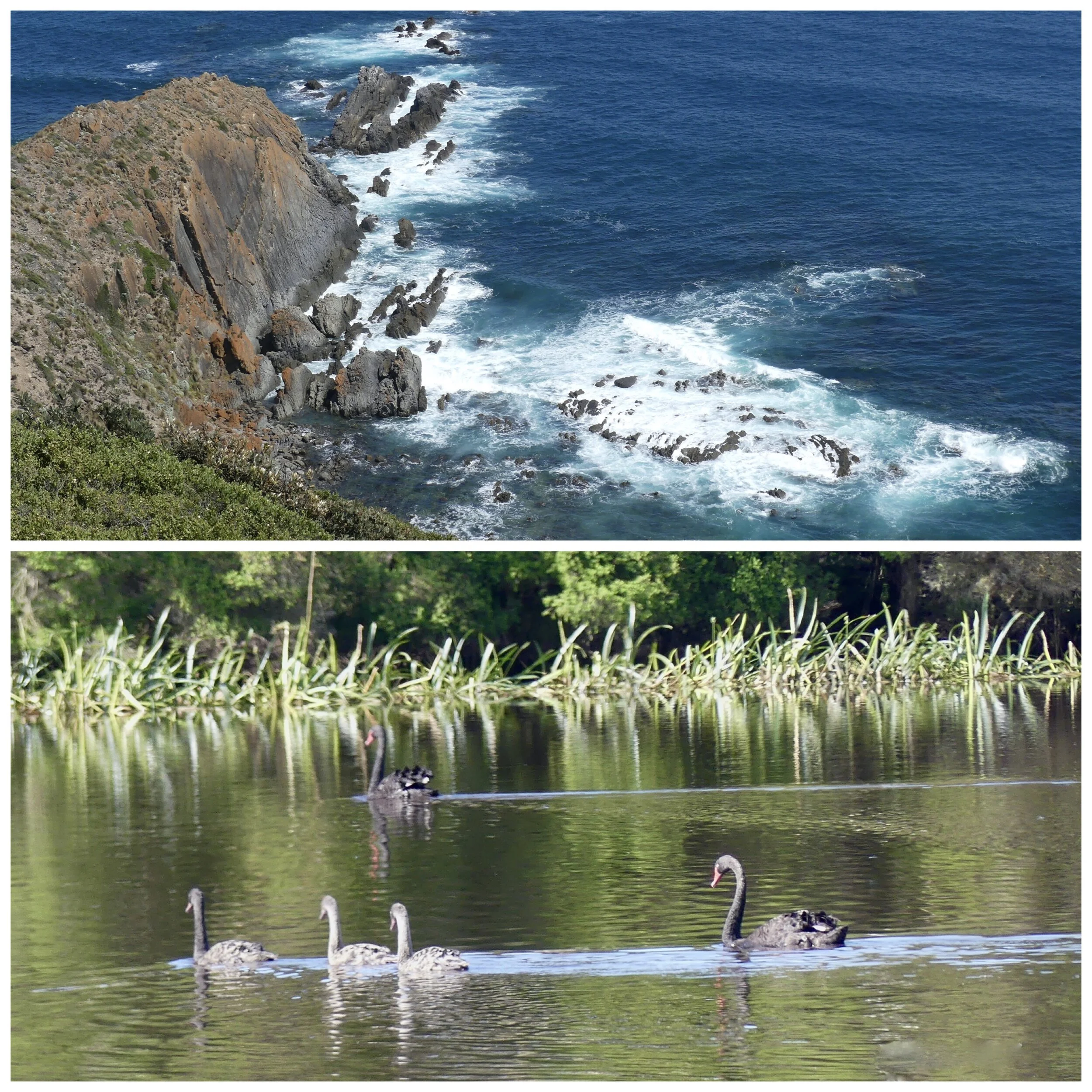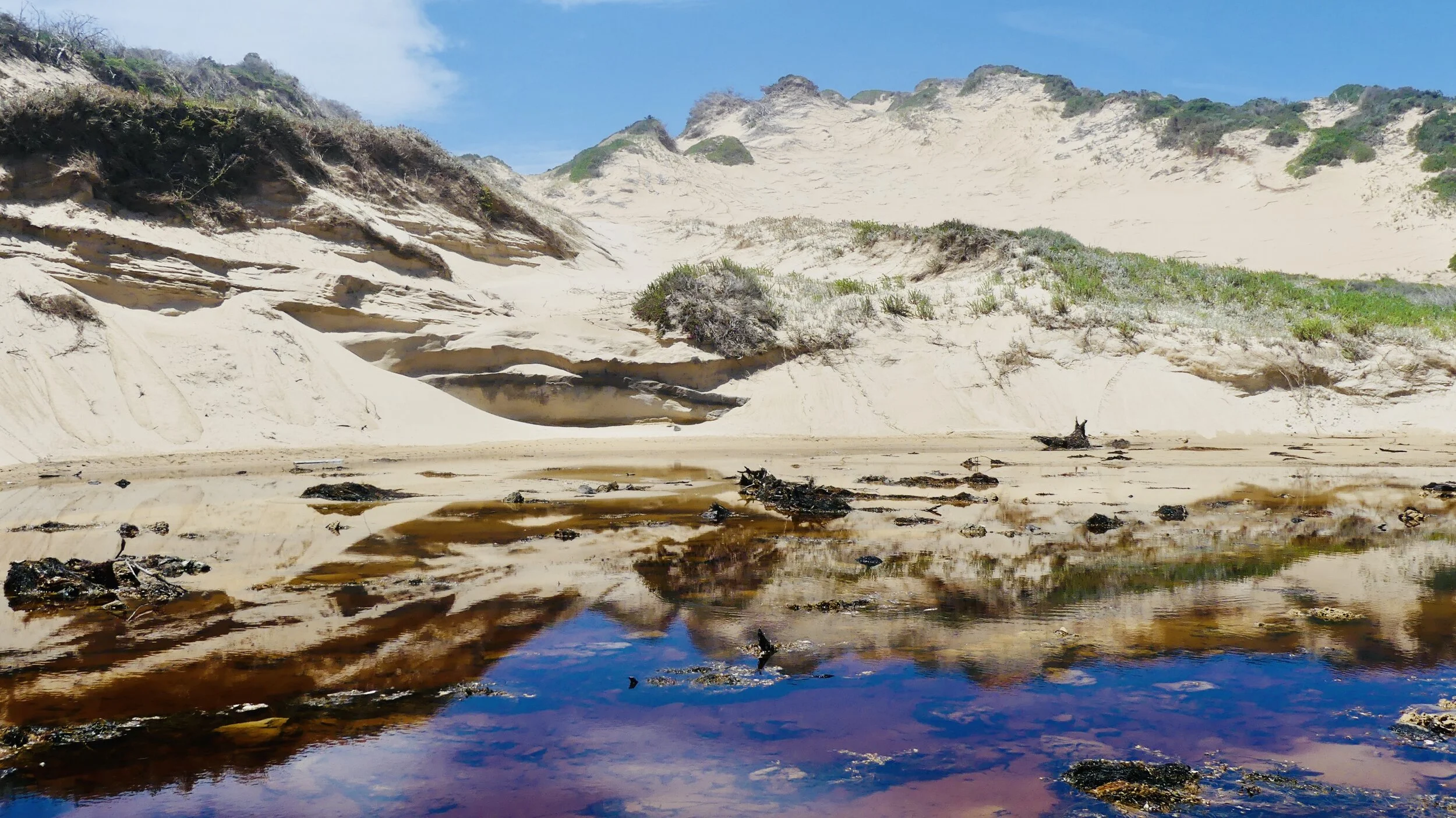Lesser-known delights
Sometimes there are surprises just around the corner from more acclaimed destinations. They fly under the tourism radar and are emptier of the kind of people who leave their litter by an overflowing bin, and think No Dogs doesn’t apply to them because they’re ‘local’.
To the west of Wilsons Promontory in South Gippsland, Waratah Bay Foreshore Reserve is a narrow strip of Crown (public) land that retains most of its natural values. The beach is popular with surfers when conditions are favourable. There was no one there on this November day: what a find.
Wilsons Prom from Waratah Bay beach
In t’other direction
I didn’t have great expectations, so Waratah Bay was easily more impressive than I’d imagined. I like lines in the sand and swirls in the sky, and bands of colour and texture. The lines in the sand at Waratah Bay beach were almost unnatural. As I walked the long stretch of emptiness, I started with a simple observation: after 11 years and many glorious sandy beaches, how can I still get excited about coming across another one? This soon evolved into imponderables: how will I live without beaches of the calibre of Australian beaches? How dull will be weeks and months without ocean vistas? Am I potentially a classic victim of having lived in highly contrasting countries; two hemispheres; opposite corners of the planet; forever condemned to nagging dissatisfaction of a lesser or greater degree about one thing or another? These are conjectural questions that are part of a big topic; and this is a post about the simple pleasures of discovering new delights in the natural world. So I shall put off until tomorrow things I don’t have to fathom today.
We had to backtrack in order to head further west towards Walkerville before turning off for Cape Liptrap. On the way there was a lookout over to the Prom.
Liptrap struck me as rather an odd name. The headland was first sighted in 1800 by James Grant, navigator aboard HMS Lady Nelson which was surveying the Australian coast. He named it after John Liptrap. There was a John Liptrap who was a Sheriff of London in 1796; and a John Liptrap who became a Fellow of the Royal Society in 1802; or maybe it was the name of Lt Grant’s best mate. I searched for an Aboriginal name, but couldn’t find one. Geographical features named after prominent British dignitaries are bad enough, but those of obscure non-entities are worse.
Roughly 200 km southeast of Melbourne, Cape Liptrap Lighthouse isn’t tall. The tower is 10 metres high and its range is 30 km. It replaced a 6-metre steel tower erected in 1913. Wrecks were not uncommon off the Cape: submerged rocks abound, and parallel rocky ridges run out into Bass Strait at right angles to the headland. Those mariners shipwrecked off this remote headland faced little chance of rescue.
Wave-cut platform
Wilsons Prom from Cape Liptrap
There’s a gravel road for the final few kilometres to the lighthouse, but don’t be put off. It’s not a bad surface and you don’t need a 4x4.
About half-an-hour north of Cape Liptrap is Bald Hills Wetland Reserve, off the C442 on another unsealed road for a few kilometres, but worth it. There is stunningly beautiful paperbark woodland before you reach a wetland with a new hide from which to spy on birdlife. It’s about 15 minutes one-way to the water, unless you’re a photography fanatic or you stop to listen to birdsong, but watch out for snakes in their awake season – September to April in Victoria.
Grey Teal
Eastern Yellow Robin
Olive Whistler
Lichen yellow
Duckweed pink
Eastern Blue-tongued Lizard
Finally, there was something completely different. We decided to explore east of The Prom before heading back to Melbourne. We had read about Port Welshpool Long Jetty, extending 800 metres into Corner Inlet. A jetty was first built here in the 1850s for the shipping of cattle to Tasmania and New Zealand. It was long to enable larger vessels to reach it using a deep channel parallel to the shore; and curved so a train could be run along it to transport fish to Melbourne A jetty train line was never constructed, however, and the jetty was closed for many years after it became unsafe due to the corrosive effects of seawater. But following a multi-million dollar restoration, the Long Jetty today offers a great opportunity to walk far out into Corner Inlet.
The Prom from the end of Long Jetty
It was quite possibly the most impressive jetty ever.



